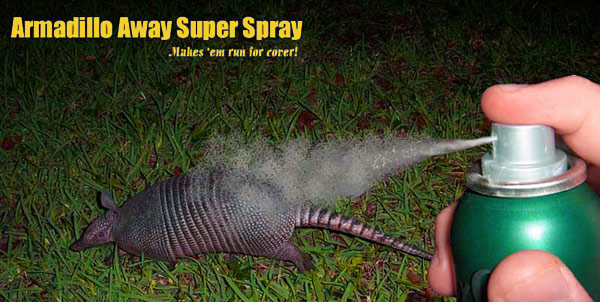- info@wildlife-removal.com
Call us for help in your town
Wildlife Removal Education
Keep Armadillos Out of Yard or Garden
Need armadillo removal in your hometown? We service over 500 USA locations! Click here to hire us in your town and check prices - updated for year 2020.
Below is my advice for keeping armadillos out of your yard, garden, or other property. However, if it proves ineffective in your case, you have the option to hire a Professional Wildlife Removal Company in
your area to humanely trap and relocate the problem dillo. You may also email me with any questions you have.

Yes, you are being overrun by armadillos. Why? Because there is something tasty hidden in the soil of your lawn and garden. An armadillo will move impressive amounts of soil in the search of insects and grubs. A pristine lawn may be littered with holes
after just one night. For such an interesting, peaceful creature, armadillos sure can be nuisances when they wander into places people don’t want them.
If you have an armadillo issue already, your options are limited. Chances are the creature is burrowed right into your yard, under your porch, or somewhere else you can’t easily access. Because an armadillo can dig out of any hole, you can’t
just close the entrance to its burrow. You have to make the armadillo want to leave of its own accord. Some people believe that due to the extremely delicate sense of smell armadillos have, the task of making them move on isn’t incredibly difficult. Old wives tales
state that a towel, soaked with ammonia,
can be placed down in the burrow, or that mothballs have also been known to be potent enough to move an armadillo out, as long as the pest does not just bury the mothballs to eliminate the odor. However, these repellents are completely ineffective. Go ahead and
use them if you wish, but the armadillo will not leave your yard or garden. There is no cheap powder or spray or any product that will make the armadillos go away from your property. Read the guide How to Tell Whether You Have An Armadillo Under Your Shed Or Porch.

Since using the armadillo’s sense of smell against it doesn’t do the trick, you can create a special door over the entrance to the burrow. This door can be made of metal fencing or any sturdy material that allows the animal to see through to the outside.
Cut the fencing so that it is larger than the hole and secure it over the opening. When the armadillo exits, the wire door will fall back into place, but the wide margins on the outside will prevent re-entry into the burrow. Once an armadillo is out,
it can be trapped, and relocated to a place better suited to its needs. Armadillos tend to wander, so you will want to make sure the area you release the animal into has a plentiful amount of food, water, and cover.
The best way to keep armadillos out of the yard is to buy a fence. This fence will probably be expensive if your neighbors are sticklers about neighborhood aesthetics. An armadillo fence must be sturdy, and though it does not need to be tall,
it does need to go into the ground at least a few feet. Armadillos are amazing diggers, so anything less than a few feet into the ground will be insufficient. A fence is also the best way, the only way really, to keep armadillos out of your garden.
Next, if you want to know how to keep armadillos out of the flower beds or landscaping, you will want to make your area smell as unappealing as possible—to an armadillo. Or make it as inaccessible and unhospitable as possible. Special
plants and bushes are available that emit strong odors, and vegetation of this type can still be pleasing to the eye. Heavy use of wood chips is actually the best way to keep them away from a flower bed, since they can't dig through these wood chips nearly
as easily. Lacing the perimeter of your property with mothballs or ammonia-soaked cotton doesn't work, though heavy plant use might in some cases, and
will require regular maintenance and replenishment.
Even with your property armed and prepared for an armadillo invasion, there is one more thing you can do to keep armadillos away. Eliminating the alluring treats within your soil will make the armadillos look to your neighbor’s yard instead.
To eliminate many types of insects that armadillos like, you will need to purchase special nematodes: parasitic worms that live off of the armadillo’s food source. Without a ready food supply, the armadillos will have no need to dig through your property.
Because of the gentle nature of armadillos, it is not necessary to kill them to eliminate them from your yard. With a little patience and research, you can be free from the shackles of armadillo terrorists before anyone gets hurt.
There is a relatively cheap and easy solution. Just trap the armadillos in cage traps, and then relocate them far away from your property. That's it. That's the only effective way to keep away armadillos. But it works, and works very well. If you want to learn more about
the process, click this link about how to trap an armadillo. Basically, you just need to set a large
sturdy cage trap on the armadillo's path, or even right over the burrow. Make sure it's flush with the ground and doesn't rattle. No bait needed.
If you want to learn more about armadillo behavior and biology, go to may main armadillo removal page, where I describe techniques on how to keep armadillos out of the garden, yard, or anywhere on your property.


















